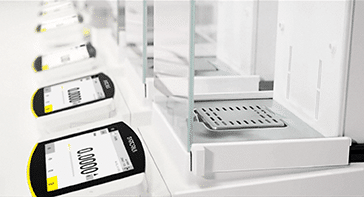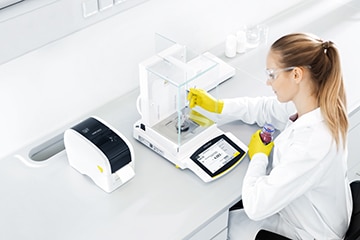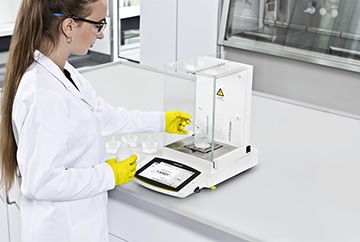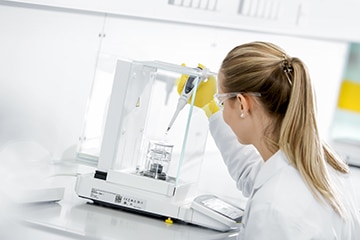The following post was provided by Sartorius, our featured manufacturer this month. Sartorius manufactures high quality laboratory balances & is a trusted partner for the Biopharmaceutical industry & laboratories. Sartorius provides everything you need for success in the Life Science, Biopharmaceutical Manufacturing, Quality Control and Testing, and Applied Industries.
Ensure Laboratory Balances Produce Reliable Weighing Results
Today, balances are used in many processes and tasks in laboratories. Weighing is one of the most frequently done, critical and time-consuming activities. Measurement errors that occur during weighing can have negative effects on the entire process.
Today, laboratory balances have been perfected so that even weighing of very small amounts of substances can be done quickly, easily and yet with the most reliable results.
However, weighing still remains a critical process, which is affected by physical effects and the ambient conditions at the installation site. Some sample properties, such as the evaporation of liquids or static electricity of the sample, can also affect the weighing result. That is why knowing about possible disturbance variables and how to minimize them is useful and necessary to perform high-precision weighing and avoid misinterpretations of weighing results.
The Working Space & Laboratory Balance Repeatability
 One of the most important characteristics of a balance is the standard deviation of the repeatability measurement. It is very important in calculating the measurement uncertainty and determining the minimum weight of a balance. The result of the repeatability measurement is closely linked to the ambient conditions at the location of the balance.
One of the most important characteristics of a balance is the standard deviation of the repeatability measurement. It is very important in calculating the measurement uncertainty and determining the minimum weight of a balance. The result of the repeatability measurement is closely linked to the ambient conditions at the location of the balance.
In addition, unfavorable installation conditions can lead to longer measurement times and unstable weighing values. The following points should be taken into consideration when choosing the installation location and the equipment installation in order to fully utilize a laboratory balance.
The working space should be low-vibration. Building vibrations that, for example, result from vibrations of machines, can negatively impact the weighing result. Air movement from windows, heat sources, air conditioning system outlets or fans on technical equipment (PC or other laboratory equipment) creates turbulence, which affects the weighing result. The installation location should therefore be as free of disruptive air movements as possible. Access to laboratory rooms should ideally occur using a sliding door in order to reduce air flows caused by the door movement. Air conditioning systems should be set to a low air flow (take protective measures if necessary).
The Weighing Table
Weighing tables should be placed in the corner of the room if possible, as this is the place in a building with the least amount of vibration. Weighing tables should be as stable as possible. A permanently installed laboratory table, laboratory cabinet or a special weighing table with a stone slab is best. The weighing table should be so stable that it does not bend when leaning on it and so that it does not transmit any vibrations if possible. The balance display may not change when leaning on the table. Weighing tables should be anti-magnetic (no steel plate) and protected against static discharge (no plastic or glass). Soft pads, such as writing mats, under the laboratory balance, should always be avoided. The weighing table should either be on the ground or attached to the wall. A special weighing table can increase the quality of measurement results, especially for semi-micro and microbalances.
Other Factors that Impact Laboratory Balance Results

Temperature
Balances can exhibit a drift (slow change of the balance indication) due to temperature changes. The temperature drift is typically 1 ppm/K to 2 ppm/K for laboratory balances. At a temperature change of 4 K (i.e. from 19 °C to 23 °C) for example, this means an apparent change in mass by 4 ppm to 8 ppm. At a mass of 100 g, this is 0.4 mg to 0.8 mg. Laboratory balances must therefore be adjusted before use in the event of temperature changes. The room temperature in the laboratory should be as constant as possible. Direct sunlight at the balance installation location (and the heat development it causes) should be avoided. Darkened windows are ideal. Balances should not be placed in direct proximity to heaters or windows. The specified application temperature range of the balances, as described in the balance technical specifications, must be observed.

Air Humidity
The relative humidity (rH) at the balance installation location should be between 40 % and 60 %. A relative air humidity of 20 % to 80 % should never be fallen short of or exceeded, as condensation can occur at very high humidity or electrostatic effects can occur at very low humidity.
It is recommended to monitor the air humidity and temperature in the laboratory continuously. Sartorius offers what are known as climate modules to easily monitor air humidity, temperature and air pressure. With some balances, these can be installed directly in the rear panel of the draft shield. The climate data can then be displayed via the balance display and printed out with weighings.

Draft
High-resolution laboratory balances always have what is known as a draught shield to protect the weighing chamber from the influence of disruptive air flows. Nevertheless, the following points should be observed: Laboratory balances should not be installed in the airflow of air conditioning systems or heaters. Balances should not be installed next to doors and windows. High-resolution balances should not be operated in highly frequented places, as moving people cause a draught. Laboratory balances should not be disconnected from the mains at night or on the weekends, as otherwise the warm-up time has to be adhered to again when turned back on. Laboratory balances should therefore only be switched into standby mode when not in use. Avoiding position changes of the balance in continued operation increases the reliability of your weighing results.
We hope that you found this post informative! Please be sure to visit our website at www.sartorius.com for more information on Sartorius balances.
Need help finding the right laboratory balance for your application?
No matter what level of accuracy your application requires, the Michelli Weighing & Measurement team can help you find the best laboratory balance. Contact your nearest location today to speak with a product specialist.

